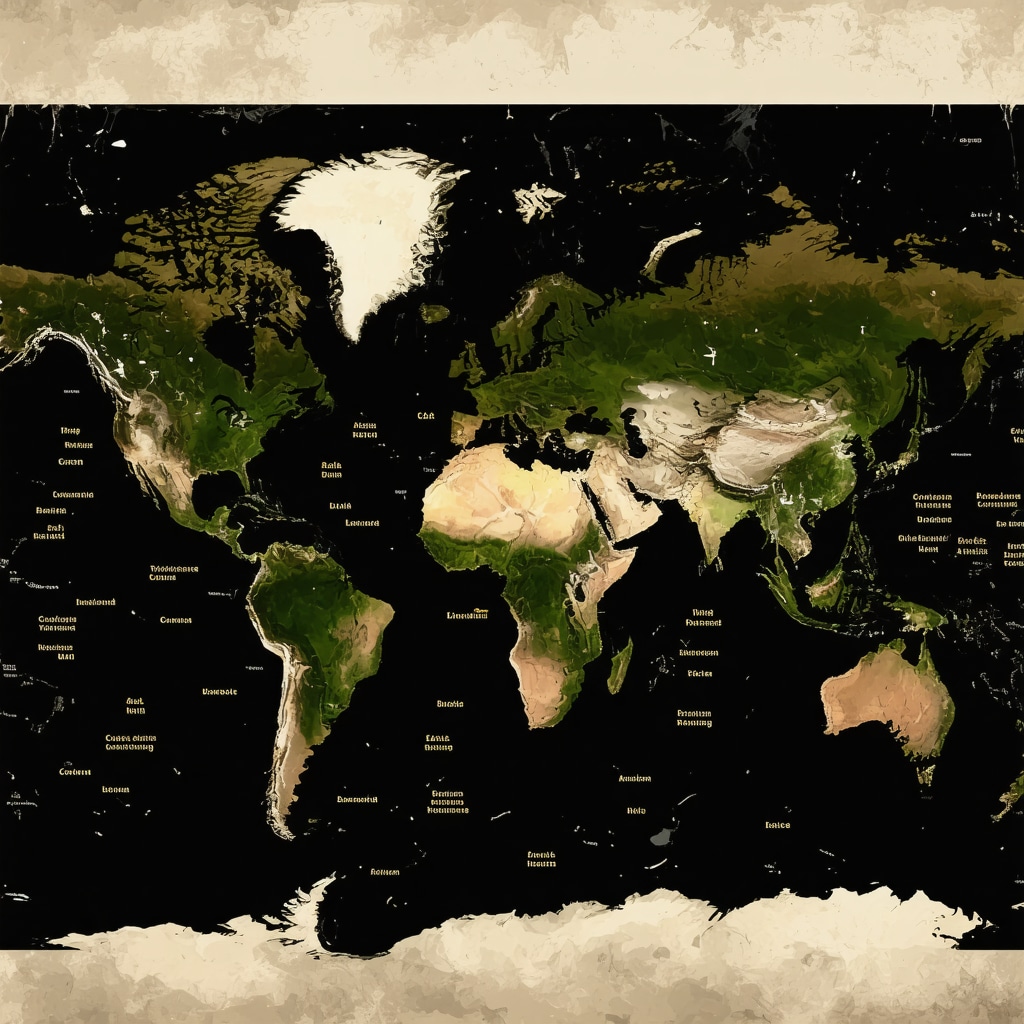The Strategic Significance of Central Bank Gold Accumulation in 2025
As seasoned financial analysts and investors look ahead to 2025, understanding the nuanced influence of central bank gold purchases on global price trajectories becomes paramount. Central banks, traditionally viewed as custodians of monetary stability, are increasingly engaging in gold acquisitions as part of their diversified reserve management. This shift is driven by geopolitical uncertainties, inflation hedging strategies, and a desire for monetary sovereignty, which collectively shape the demand-supply dynamics in the gold market.
Deciphering the Interplay Between Monetary Policy and Gold Markets
In 2025, central bank interventions through gold purchases could significantly alter the equilibrium, especially amid ongoing inflation concerns and fluctuating US dollar strength. Historically, such large-scale acquisitions have served as signals of confidence in gold’s role as a safe haven, potentially catalyzing upward price movements. Moreover, the strategic accumulation by nations like China and Russia demonstrates a deliberate effort to counterbalance US dollar dominance, thus embedding gold more deeply into the geopolitical economic fabric.
How Will Gold Supply and Demand Dynamics Evolve in 2025?
Analyzing supply-side factors, including mining outputs and recycled gold flows, along with demand from sectors such as jewelry, technology, and investment, reveals complex interdependencies. The rise of gold ETFs and institutional holdings further amplifies these trends. As central banks increase their gold reserves, the resulting surge in demand could outpace supply growth, especially if mining production faces geopolitical or environmental constraints, leading to potential price appreciation.
What Are the Long-term Implications of Central Bank Gold Accumulation on Price Volatility?
Expert discussions suggest that sustained central bank buying could introduce both stability and volatility into the gold market. On one hand, steady reserve expansion might serve as a buffer against macroeconomic shocks. On the other hand, if coordinated sales or policy shifts occur, they could trigger abrupt price corrections. Investors must therefore monitor central bank policies closely, integrating this insight into their broader asset allocation strategies.
Integrating Gold into a Diversified Portfolio for 2025
Given these dynamics, savvy investors are considering gold not merely as a hedge but as an integral component of their wealth preservation tactics. Exploring options such as gold ETFs, physical bullion, and mining stocks allows for tailored exposure aligned with risk appetite. For a comprehensive understanding, reviewing the role of gold ETFs in 2025 offers valuable insights into effective diversification strategies.
As the landscape evolves, staying informed about central bank movements and macroeconomic indicators remains critical. For an in-depth analysis of upcoming economic influences, consult expert predictions on the future of the gold market.
Reevaluating Gold as a Geopolitical Hedge in 2025
As global tensions persist and geopolitical shifts accelerate, central banks’ gold reserve strategies become even more critical. The deliberate accumulation of gold by nations such as China and Russia signals a move towards greater monetary sovereignty and resilience against currency devaluation. This trend raises an intriguing question:
Could increased central bank gold reserves fundamentally alter the geopolitical landscape of currency dominance?
Experts argue that such shifts might lead to a diversification of reserves away from the US dollar, potentially fostering a multipolar monetary environment. For investors, understanding this evolving landscape is key, as it influences not only gold prices but also broader currency and commodity markets. For a detailed analysis of supply-demand dynamics and geopolitical implications, see how gold acts as a hedge in 2025.
Advanced Tools for Navigating Price Volatility in 2025
Given the potential for increased volatility stemming from central bank activities and geopolitical tensions, investors should leverage sophisticated analytical tools. Quantitative models such as technical analysis combined with macroeconomic indicators can help predict short-term price swings. Additionally, options strategies like collars or straddles offer ways to hedge against adverse movements while maintaining exposure to upward trends. For practical guidance, explore best practices for buying gold and advanced investment techniques for 2025.
How Will Market Sentiment Be Shaped by Central Bank Policies?
Market sentiment in 2025 will likely be heavily influenced by central bank signaling—whether through public statements, reserve adjustments, or strategic sales. The psychology of markets, driven by investor perceptions of stability versus risk, can trigger rapid shifts in gold demand. Understanding these behavioral cues is crucial for timing entry and exit points. As noted by financial analysts, the integration of sentiment analysis with fundamental data can provide a competitive edge. For more insights into sentiment-driven trading, see gold market analysis in 2025.
Share your thoughts below—how do you see central bank actions shaping gold prices in the coming year? For more expert insights and strategies, consider reading expert tips for gold investment in 2025.
Analyzing the Impact of Central Bank Gold Reserves on Market Stability and Price Fluctuations in 2025
As we delve deeper into the 2025 gold landscape, it becomes evident that the strategic accumulation of gold reserves by central banks plays a pivotal role in shaping market stability and price volatility. Unlike traditional monetary tools, gold reserves are increasingly viewed as a safeguard against currency devaluation, geopolitical upheaval, and macroeconomic shocks. This shift prompts a nuanced examination of how central bank policies influence the gold market’s intricate dance of supply and demand.
What Mechanisms Do Central Banks Use to Influence Gold Prices?
Central banks influence gold prices primarily through reserve management strategies, coordinated buying or selling, and signaling to markets about their monetary posture. When a country like Russia or China increases its gold holdings, it often sends a signal of diversification away from the US dollar, potentially bolstering gold’s appeal as a reserve asset. According to the International Monetary Fund’s report on reserves (IMF, 2023), such moves can impact global liquidity flows and trigger price adjustments, especially when combined with market perceptions of geopolitical risk.

How Do Gold Reserve Accumulations Affect Market Volatility?
Expert analysis suggests that sustained increases in central bank gold reserves can serve as a stabilizing force during economic turbulence. However, abrupt shifts—such as sudden sales during geopolitical crises—may induce sharp price swings. The key lies in the transparency and communication of these reserve adjustments. For example, the IMF’s recent study highlights that predictable reserve policies tend to reduce market uncertainty, whereas unpredictable moves heighten volatility.
Market participants must, therefore, monitor official statements, reserve reports, and geopolitical developments to anticipate potential price shocks. Advanced traders often incorporate real-time data feeds and sentiment analysis tools to gauge the market’s reaction to central bank activities, enabling more informed decision-making.
Can Gold Reserves Serve as a Buffer During Global Economic Shocks?
Indeed, central banks often deploy gold reserves as a form of insurance during periods of extreme volatility. The 2008 financial crisis and the recent COVID-19 pandemic underscored gold’s role as a safe haven. Maintaining substantial reserves allows nations to stabilize their economies and reassure markets. The World Gold Council’s 2024 report indicates that central banks’ gold holdings have reached historic highs, reflecting a collective move towards resilience.1 This accumulation not only influences global pricing but also signals confidence in gold’s long-term value. Investors, therefore, benefit from understanding these reserve dynamics, especially when geopolitical tensions escalate.
How Might Future Policy Shifts Alter the Gold Market?
Looking ahead, the potential for policy shifts—such as coordinated reserve sales or new regulations—poses a significant risk to gold price stability. Central banks may also pivot towards more transparent policies aligned with sustainable development goals, affecting their reserve strategies. Additionally, technological innovations in gold trading platforms, coupled with geopolitical realignments, could introduce new dimensions of volatility or stability.
For investors eager to navigate this complex terrain, staying abreast of central bank reports, geopolitical developments, and macroeconomic indicators remains critical. Engaging with expert analyses, such as those found in the Gold Council’s research publications, can provide valuable foresight into potential market trajectories.
In conclusion, the evolving strategies of central banks regarding gold reserves are more than mere reserve management—they are integral to the broader fabric of global economic stability. How these policies unfold in 2025 will undoubtedly influence gold’s role as both a safe haven and a strategic asset, making it essential for investors and policymakers alike to monitor these developments closely.
Unveiling the Hidden Dynamics of Central Bank Gold Strategies in 2025
As we venture further into 2025, it becomes increasingly evident that central banks are employing sophisticated reserve management tactics that profoundly influence global gold prices. Beyond mere accumulation, these strategies encompass geopolitical signaling, digital asset integration, and innovative reserve diversification, which collectively shape market sentiment and stability.
The Role of Digital Assets in Central Bank Reserves: A Paradigm Shift?
Emerging research suggests that some central banks are exploring digital assets and cryptocurrencies as adjuncts or alternatives to traditional gold holdings. The integration of blockchain technology into reserve management could usher in unprecedented transparency and efficiency, redefining the very fabric of monetary sovereignty. According to a IMF working paper (2024), this evolution might influence gold’s role as a reserve asset, either complementing or competing with digital alternatives.
How Are Geopolitical Tensions Reshaping Gold Reserve Policies?
In an era marked by geopolitical realignments, nations are increasingly leveraging gold reserves as strategic tools. The deliberate accumulation by countries like India and Turkey signals a shift towards greater monetary independence, especially amidst fluctuating US dollar dominance. This behavior underscores a broader trend: gold’s emergence as a geopolitical currency, capable of counterbalancing economic sanctions and currency devaluations.

What Are the Advanced Analytical Techniques for Monitoring Gold Market Fluctuations?
Investors and policymakers now leverage cutting-edge analytical tools such as machine learning models, sentiment analysis, and real-time geopolitical risk assessments to predict gold price movements. These technologies enable nuanced interpretation of complex market signals, facilitating proactive decision-making. For instance, integrating AI-driven forecasts with macroeconomic data can reveal subtle shifts in market dynamics well before they materialize.
How Can Investors Strategically Position Themselves Amidst Evolving Reserve Policies?
Given the multifaceted changes in reserve management, diversification remains paramount. Sophisticated strategies include deploying a combination of physical gold, gold ETFs, and futures contracts, tailored to risk tolerance and market outlooks. Engaging with expert resources such as the Gold Council’s latest research can enhance tactical decision-making, aligning portfolios with emerging market realities.
What Future Policy Shifts Could Disrupt the Gold Market Trajectory?
Anticipating future policy maneuvers—such as coordinated reserve sales, international treaties, or regulatory reforms—requires vigilant monitoring. Policy shifts, especially those aimed at digital currency regulation or reserve transparency, could introduce volatility or stability. The potential for central banks to adopt more transparent and sustainable reserve strategies promises a landscape where gold’s role as a hedge and strategic asset continues to evolve.
Engage with the Cutting Edge of Gold Market Intelligence
To navigate the complexities of 2025’s gold landscape, investors and analysts must harness advanced data analytics, geopolitical intelligence, and expert insights. Staying ahead demands active engagement with specialized resources and continuous learning. Follow industry leaders and institutions such as the World Gold Council for authoritative updates and strategic guidance. Dive into these insights now to refine your investment approach and secure a resilient financial future.
Expert Insights & Advanced Considerations
1. Strategic Diversification of Reserves Will Accelerate
Central banks are increasingly diversifying their reserves with gold, signaling a shift towards greater monetary sovereignty and financial resilience amid geopolitical tensions and currency fluctuations.
2. Digital Asset Integration Will Transform Reserve Management
The adoption of blockchain and cryptocurrencies by some central banks suggests a future where gold reserves are complemented or even partially replaced by digital assets, enhancing transparency and operational efficiency.
3. Geopolitical Tensions Will Drive Gold as a Geopolitical Currency
Countries leverage gold reserves strategically to counterbalance US dollar dominance, which may lead to a multipolar monetary environment and alter global currency dynamics.
4. Advanced Analytical Tools Will Become Essential
Machine learning, sentiment analysis, and real-time geopolitical risk assessments will be crucial for investors and policymakers to navigate the evolving gold market landscape effectively.
5. Reserve Policies Will Impact Price Volatility
Predictable and transparent reserve management by central banks tends to stabilize markets, whereas unpredictable shifts can induce volatility, emphasizing the importance of monitoring official communications and geopolitical developments.
Curated Expert Resources
- World Gold Council: An authoritative source for in-depth research and market analysis on gold, providing strategic insights into trends and policy impacts.
- IMF Working Papers: Offers comprehensive research on reserve management, including the influence of digital assets and geopolitical factors on reserve strategies.
- Gold.org: The official site of the World Gold Council, featuring data, reports, and expert analyses relevant for serious investors and policymakers.
- Academic Journals on Monetary Policy: Peer-reviewed publications providing detailed examinations of reserve diversification, digital currencies, and geopolitical influences on gold.
- Financial Data Platforms (Bloomberg, Reuters): Real-time data and analytics tools that support advanced market analysis and decision-making.
Final Expert Perspective
In 2025, understanding the evolving role of central bank gold reserves is crucial for investors aiming to navigate complex geopolitical and macroeconomic landscapes. The strategic shifts in reserve management, combined with technological innovations and geopolitical considerations, will continue to shape gold’s role as a safe haven and strategic asset. Engaging with authoritative resources and leveraging advanced analytical tools will be essential for staying ahead. Your insights and questions are welcome—connect with industry experts and deepen your understanding of this dynamic field to refine your investment approach and contribute to a more resilient financial future.










